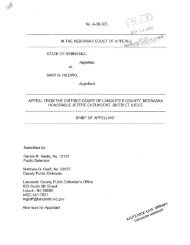Financial Articulation of a Fiduciary Duty to Bondholders with ...
Financial Articulation of a Fiduciary Duty to Bondholders with ...
Financial Articulation of a Fiduciary Duty to Bondholders with ...
You also want an ePaper? Increase the reach of your titles
YUMPU automatically turns print PDFs into web optimized ePapers that Google loves.
1986] FIDUCIARY DUTY TO BONDHOLDERS<br />
Also, this Article sketches a new line <strong>of</strong> development for corporate<br />
law based upon a new fiduciary articulation which reconciles the corporate<br />
conflict <strong>of</strong> interest between "bondholders" and s<strong>to</strong>ckholders.<br />
Because <strong>of</strong> the national influence <strong>of</strong> Delaware's law <strong>of</strong> corporations 7<br />
and because <strong>of</strong> the elegance <strong>of</strong> the generalized fact pattern in Weinberger<br />
v. UOP, Inc. ,8 this Article employs aspects <strong>of</strong> Weinberger in an<br />
illustrative discussion <strong>of</strong> the new fiduciary articulation.<br />
II. THE CORPORATE-FINANCE FRAMEWORK<br />
A. CORPORATE CURRENT-MARKET-VALUE MAXIMIZATION<br />
An operating decision "efficiently" uses corporate assets when it<br />
maximizes their present value; 9 an operating decision "wastes" corporate<br />
assets when it reduces their present value.' 0 Corporate "financing<br />
decisions" are decisions regarding methods <strong>of</strong> providing capital <strong>to</strong><br />
the corporation." Corporate debt is "risky" when there is a chance<br />
that the corporation might not be able <strong>to</strong> make full payments on all<br />
its debt promises. 12 A "side payment" is a transfer <strong>of</strong> wealth between<br />
classes <strong>of</strong> the corporation's securityholders.1 3<br />
A central problem for the corporation is that there is, in general,<br />
no way <strong>of</strong> directly constructing managerial objectives from the diverse<br />
preferences <strong>of</strong> the corporation's securityholders. 14 This<br />
6. The term "bond" is used herein for all debt securities. See AM. BAR FOUND.,<br />
COMMENTARIES ON INDENTURES 7 n.3, 8 (1971). For a discussion <strong>of</strong> the "investment<br />
contract" definition <strong>of</strong> a security, see Schneider, The Elusive Definition <strong>of</strong> a Security,<br />
14 REV. SEC. REG. 981 (1981) (discussing the definition <strong>of</strong> security under the federal<br />
securities laws). For a discussion <strong>of</strong> inves<strong>to</strong>r interest in bonds, see Ehrlich, The Smorgasbord<br />
<strong>of</strong> Bonds: Something For Almost Every Palate, Bus. WK., -, 122 (Dec. 30,<br />
1985). The distinction between debt and equity is irrelevant <strong>to</strong> the conflict <strong>of</strong> classes <strong>of</strong><br />
securityholders having nested claims on the corporation's assets and cash flow. The<br />
term "s<strong>to</strong>cks" is used herein as a parallel <strong>to</strong> the term "bonds," and means "shares <strong>of</strong><br />
s<strong>to</strong>ck" or "s<strong>to</strong>ck."<br />
7. See Black, Jr., A National Law <strong>of</strong> Takeovers Evolves in Delaware, Legal<br />
Times, Nov. 25, 1985, at 6, col. 1.<br />
8. 457 A.2d 701, 704-08 (Del. 1983).<br />
9. In other words, the decision selects the use <strong>with</strong> the largest present value <strong>of</strong><br />
its expected value. See E. FAMA & M. MILLER, THE THEORY OF FINANCE 180 (1972).<br />
The expected (mean) value is the sum over all outcomes <strong>of</strong> each outcome times the<br />
chance <strong>of</strong> that outcome occurring. See id.<br />
10. In other words, the decision selects a use <strong>with</strong> a present value <strong>of</strong> its expected<br />
value which is less than the present value <strong>of</strong> the assets. See Stiglitz, Some Aspects <strong>of</strong><br />
the Pure Theory <strong>of</strong> Corporate Finance: Bankruptcies and Take-Overs, 3 BELL J. ECON.<br />
& MGMT. SCI. 458, 460-62 (1972).<br />
11. See E. FAMA & M. MILLER, supra note 9, at 109, 150-57.<br />
12. Id. at 152 n.5, 179.<br />
13. See id. at 179-80. A "side payment" is a payment made on the side.<br />
14. Id. at 67-68 (discussing Arrow's proposition stated in K. ARROW, SOCIAL<br />
CHOICE AND INDIVIDUAL VALUES 48-59 (2d ed. 1963)). See generally J. KELLY, ARROW<br />
IMPOSSIBILITY THEOREMS (1978).








